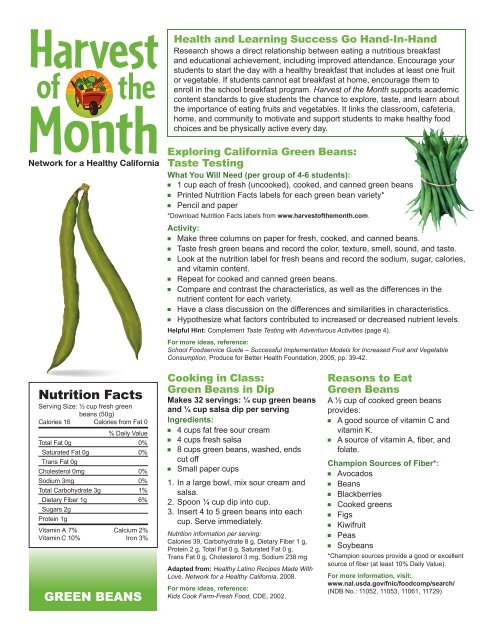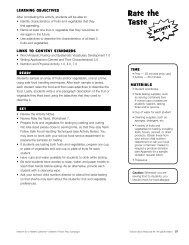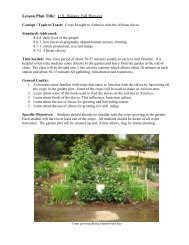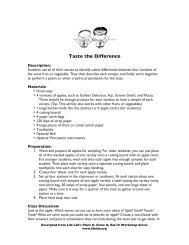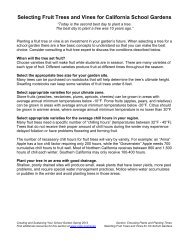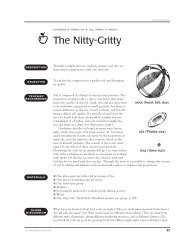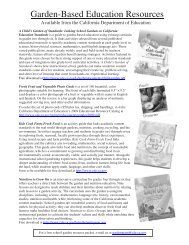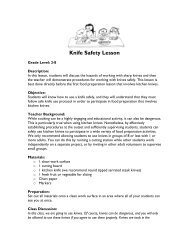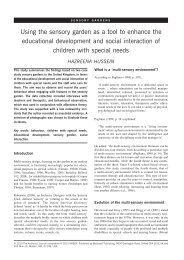Green Beans - Harvest of the Month
Green Beans - Harvest of the Month
Green Beans - Harvest of the Month
- No tags were found...
You also want an ePaper? Increase the reach of your titles
YUMPU automatically turns print PDFs into web optimized ePapers that Google loves.
S tudent Sleuths1 Why is nitrogen important for plant growth?2 What is rib<strong>of</strong>lavin? Name three things rib<strong>of</strong>lavin does for<strong>the</strong> body.3 Illustrate <strong>the</strong> two cotyledons, hypocotyl, epicotyl, andplumule that form during green bean growth.4 What were some <strong>of</strong> <strong>the</strong> harvesting techniques for greenbeans practiced by Native Americans as observed byearly explorers?5 What does <strong>the</strong> “three sisters <strong>of</strong> life” refer to in greenbean history? (Hint: Question #1 should help in findingthis answer.)For information, visit:www.fruitsandveggiesmatter.gov/month/fresh_beans.htmlwww.ipmcenters.org/croppr<strong>of</strong>iles/docs/cabeans-green.htmlwww.mypyramid.govHome Grown Factsn California ranks third in national production <strong>of</strong> greenbeans*.n Ninety-five percent <strong>of</strong> <strong>the</strong> green bean crop in California ismarketed as fresh and about five percent as processed.n Tulare, Orange, and San Luis Obispo counties are <strong>the</strong>largest green bean-producing areas in California.n O<strong>the</strong>r counties that contribute acreage to green beansinclude Riverside, Santa Clara, Contra Costa, Stanislaus,San Diego, San Mateo, and San Bernardino.n Bush-type green beans are <strong>the</strong> predominant varietygrown for commercial production in California.*2008 DataFor more information, visit:www.anrcatalog.ucdavis.edu/pdf/7240.pdfA String <strong>of</strong> <strong>Green</strong> Bean HistoryThe common bean was cultivated in ancient Mesoamericaas early as 8,000 years ago. <strong>Beans</strong> were even found in<strong>the</strong> mummy covering <strong>of</strong> a woman in a Peruvian cemeterydating back to pre-Inca civilization. <strong>Green</strong> beans andall 200 varieties <strong>of</strong> P. vulgaris originated in <strong>the</strong> tropicalsou<strong>the</strong>rn part <strong>of</strong> Mexico, Guatemala, Honduras, and part <strong>of</strong>Costa Rica. They spread from this center <strong>of</strong> origin to Northand South America long before European explorers everarrived.Early explorers found <strong>the</strong> climbing beans planted alongsidemaize. The first drawings <strong>of</strong> <strong>the</strong> bush bean were recordedby <strong>the</strong> German doctor Leonhart Fuchs in 1542, and werealso described in detail by explorers John Verazanno andSamuel de Champlain.When first discovered, <strong>the</strong> green beans had a “string” thatran on <strong>the</strong> outer curve <strong>of</strong> <strong>the</strong> pod shell. This led to <strong>the</strong>nickname “string beans.” [See Botanical Facts (page 2) fordetails.] Botanists, however, found a way to remove <strong>the</strong>string through breeding and in 1894 <strong>the</strong> first “stringless”bean plant was cultivated. Today, nearly all varieties <strong>of</strong>edible pod beans are grown without strings.For more information, visit:www.extension.iastate.edu/healthnutrition/foodrecipeactivity/foodSchool Garden: Where <strong>Beans</strong> GrowIf your school has a garden, here is an activity you may want to implement.Look for donations to cover <strong>the</strong> cost <strong>of</strong> seeds, tools, irrigation systems,electric pumps, and any salary incurred by garden educators or o<strong>the</strong>rs.What You Will Need:n Bean seeds, soaked overnightn 4 plant containers (per group <strong>of</strong> 4 students)n Potting soiln Rulersn Graph paperActivity:n Discuss factors that impact <strong>the</strong> growth <strong>of</strong> beans(e.g., air, water, nutrients, temperature).n Divide students into groups. Distribute containers toeach group. Label containers with group name.n Students place soil in three <strong>of</strong> <strong>the</strong> four containers; add abean seed to each container.n Each group places containers in a different location: onenear sunlight, one away from sunlight and covered withdark paper, one in a cold dark place (e.g., refrigerator),and <strong>the</strong> one with no soil near <strong>the</strong> window.n Students water <strong>the</strong> seeds daily, being careful not tooverwater.n Measure weekly <strong>the</strong> growth rates <strong>of</strong> each seed usingrulers.n Graph results for each container using a bar graph.n Make predictions regarding growth over time.n Discuss how <strong>the</strong> various environmental influencesimpact <strong>the</strong> growth rate. Make connections to howfarmers are impacted by environmental influences(wea<strong>the</strong>r, drought, pollution).For more ideas, visit:www.cangc.orgJust <strong>the</strong> Factsn <strong>Green</strong> beans are nitrogen fixers, which means <strong>the</strong>y have<strong>the</strong> ability to draw nitrogen from <strong>the</strong> air and return it to<strong>the</strong> soil. Because <strong>of</strong> this, farmers <strong>of</strong>ten plant beans andlegumes in <strong>the</strong>ir crop rotations to replenish <strong>the</strong> soil.n Fresh beans are classified into two basic categories:edible pod and shell beans (also called dry beans*).<strong>Green</strong> beans are <strong>the</strong> most popular edible pod bean,while lima beans are <strong>the</strong> most common shell bean soldin <strong>the</strong> United States.*Refer to Dry <strong>Beans</strong> Newsletter on www.harvest<strong>of</strong><strong>the</strong>month.com.
Adventurous ActivitiesProblem Solving:n Use <strong>the</strong> pods and beansfrom <strong>the</strong> Taste Testingactivity (page 1) in ma<strong>the</strong>quations, fractions, and todemonstrate multiplicationtables.Example:● If <strong>the</strong>re are four podsand each pod containsthree beans, how manybeans are <strong>the</strong>re total?History Exploration:n Trace <strong>the</strong> history <strong>of</strong> <strong>the</strong> green bean back to its originsin ancient Mesoamerica. Have students research <strong>the</strong>native populations that cultivated beans and how <strong>the</strong>yused <strong>the</strong>m (e.g., food, medicine, religion). Assign groups<strong>of</strong> students with a region in North, Central, or SouthAmerica and have each group do a presentation.Creative Writing:n Use green beans in a poetry assignment or for adiscussion on literary elements such as alliteration,rhyming, onomatopoeia, similes, and metaphors.For more ideas, visit:www.nal.usda.gov/kidsS tudent ChampionsHave students brainstorm and ga<strong>the</strong>r <strong>the</strong>ir favorite healthygreen bean recipes. Ask students to visit <strong>the</strong>ir favoriterestaurant to ask what kind <strong>of</strong> green bean dishes <strong>the</strong>y haveavailable; <strong>the</strong>n <strong>of</strong>fer to provide <strong>the</strong>m with healthy recipesfeaturing green beans to promote as a “school special.”Offer to include special student-made artwork to help <strong>the</strong>restaurant show <strong>the</strong>y are supporting a local school.Literature Linksn Primary: One Bean by Anne Rockwell, Jack and <strong>the</strong>Bean Stalk by Steven Kellogg, Beyond <strong>the</strong> <strong>Beans</strong>talk–Gardening Activities for Kids by Nancy Allen Jarenka,Explore <strong>the</strong> Magic World <strong>of</strong> California <strong>Beans</strong> by <strong>the</strong>California Dry Bean Advisory Board, and Vegetables(Good for Me!) by Sally Hewitt.n Secondary: 10 Terrific Vegetables and EverythingYou Need to Grow and Know Them by <strong>the</strong> NationalGardening Association and Spill <strong>the</strong> <strong>Beans</strong> and Pass <strong>the</strong>Peanuts: Legumes by Meredith Sayles Hughes.Physical Activity CornerStudents will progress through <strong>the</strong> life cycle <strong>of</strong> a greenbean plant by playing Rock-Paper-Scissors with o<strong>the</strong>rstudents.n All students start out as seeds by walking low to <strong>the</strong>ground with arms wrapped around head until a signal isgiven to find a partner.n Students play one game <strong>of</strong> Rock-Paper-Scissors with apartner.n The winner becomes a sprout by walking upright withhands on top <strong>of</strong> head, wrists toge<strong>the</strong>r, and fingerspointing up. The o<strong>the</strong>r student remains a seed.n Continue <strong>the</strong> game until all students have grown from aseed, to a sprout, and finally to a green bean vine witharms outstretched and swaying.n Students may only pair up with ano<strong>the</strong>r student who is at<strong>the</strong> same stage.Adapted from: Physical Activity Specialist, Northcoast Region,Network for a Healthy California, 2011.For more ideas, visit:www.letsmove.govCafeteria ConnectionsWork with your schoolnutrition staff to conducta contest to determineyour school’s favorite fruitand favorite vegetable.Make it simple by usingposter boards to print out<strong>the</strong> names and pictures<strong>of</strong> various fruits andvegetables (one fruitor vegetable per board). Post <strong>the</strong> boards in <strong>the</strong> cafeteriaand give every student two colored dots: red for fruits andgreen for vegetables. Students can <strong>the</strong>n vote by placing<strong>the</strong> dot on <strong>the</strong>ir favorite fruit and vegetable. Older studentscan help with tallying <strong>the</strong> results. You can also involveschool staff to vote for <strong>the</strong>ir favorites. Post all results in acommon location to share with students and staff.For more ideas, reference:Fruits and Vegetables Galore, USDA, 2004.This material was produced by <strong>the</strong> California Department <strong>of</strong> Public Health’s Network for a Healthy California with funding from USDASNAP, known in California as CalFresh (formerly Food Stamps). These institutions are equal opportunity providers and employers.CalFresh provides assistance to low-income households and can help buy nutritious foods for better health. For CalFresh information,call 1-877-847-3663. For important nutrition information, visit www.cachampionsforchange.net. © 2011


